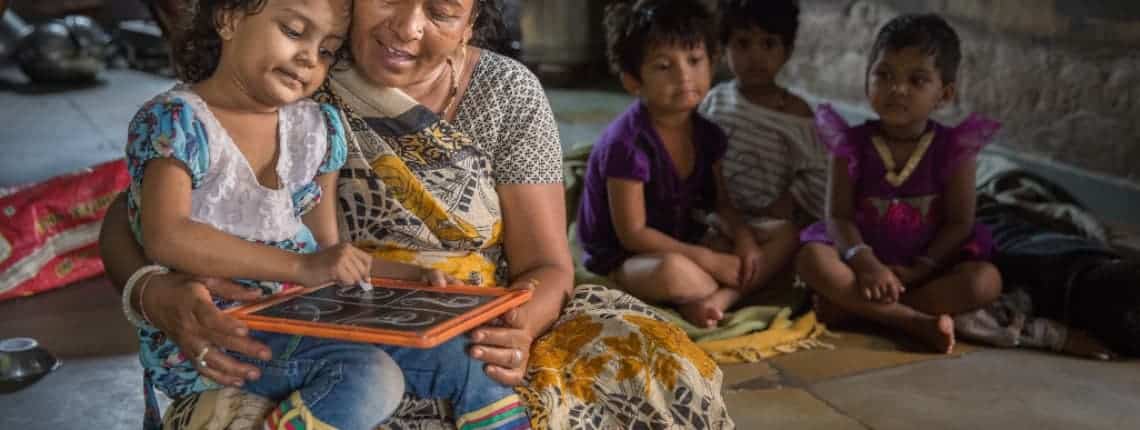This year’s World Day for Decent Work on October 7 calls for improved investment in the care economy, including child care. WIEGO’s Social Protection Team has been bringing attention to the particular childcare needs of women informal workers since launching the Child Care Campaign in 2017. Here, Rachel Moussié, Deputy Director for Social Protection, outlines four essential factors that need to be addressed to ensure childcare reaches the most vulnerable working women.
It’s not uncommon across the Global South to see women street vendors in India rocking a baby as they vend or headloaders in Accra’s markets carrying a child on their back. They bring their children with them to work out of necessity to earn. Luckily, the world is waking up to the importance of childcare services for allwomen workers and their children.
Quality public childcare is no longer seen as a service only rich countries and wealthy families can afford. The World Bank, the ILO, UN Women and UNICEF are promoting childcare services as an essential investment to ensure women can participate in the labour market, young children have the best start in life and new jobs are created in struggling economies.
Quality public child care is no longer seen as a service only rich countries and wealthy families can afford.
Governments across the global South – from Peru to Rwanda to Thailand– are investing in quality childcare services to reach the children of the working poor. For Africa, public investments in quality childcare services today could lead to huge dividends with the upcoming demographic youth bulge.
Yet, for these public and private investments in childcare to be effective, we must look at the main users of these services and what they are demanding. The responsibility for childcare – whether at home or paying for a childcare service – rests primarily on women’s shoulders. Therefore, the nature of women’s work – where they work, what they do, and who they work for – impacts their choices and uptake of childcare services. In the Global South, most working women are in the informal economy – 92% in sub-Saharan Africa, 91% in Southern Asia, and 55% in Latin America.
The responsibility for child care – whether at home or paying for a childcare service – rests primarily on women’s shoulders.
Here are four key areas that need to be taken into account and addressed in the design, financing and implementation of quality childcare services for informal working women:
- Reduce high user fees for quality childcare. Women informal workers’ earnings are low and irregular. They will never be able to pay high user fees to cover the considerable costs of running quality childcare centers. Governments must invest in free, quality, public childcare services through infrastructure, personnel, training, equipment and public subsidies.
- Invest in maternity benefits and child grants. The majority women informal workers are self-employed and do not receive a work-related maternity benefit or maternity leave. They may return to work a couple of weeks after giving birth to support their families, reducing the ability to breastfeed and sometimes exposing the child to harsh conditions for lack of choice.
Governments should invest in maternity benefits and child grants to boost the positive impacts of childcare services on children’s nutrition and health. New mothers can breastfeed for longer if they have a maternity benefit that replaces their income. In addition, childcare services should be available for children from birth to the start of primary school.
- Incorporate childcare centers into municipal plans, particularly for informal worker who work in public spaces. In a rapidly urbanizing world, women in cities work as home-based workers, construction workers, street vendors, market traders, waste pickers and domestic workers. These workers look towards the municipality to establish childcare services in their workplaces or in their neighbourhoods so they are accessible.
Municipalities have an important role to play in planning, building, and regulating childcare centres. Urban plans demarcate spaces for schools and clinics, but rarely set aside space for childcare centers. Finding space in crowded informal settlements or central marketplaces is impracticable without the support of the municipality, and rent is one of the highest costs of running a childcare center in the city.
- Increase incomes for childcare workers to improve quality and working conditions. Many childcare workers are themselves women informal workers, earning low wages without any labour or social protections. The huge societal value of quality childcare services should be reflected in the value we attribute to the work done by all childcare providers, including domestic workers caring for their employers’ children; women caring for children out of their own homes for a fee; and waged workers in childcare centers. If the childcare sector is to attract and retain workers, while also addressing persistent gender inequalities in the labour market, it must offer better incomes and working conditions for all childcare providers.
Poverty and vulnerability present women informal workers with impossible choices. If they cannot afford the fees, the location is too far or they do not trust the providers, their only option may be to take their child with them to work or transition into more flexible and lower paid work, such as home-based work. They cannot afford to stop working.
Child-care services are more likely to be used if the quality is good and women workers have confidence in the place. Child-care centres that give parents a say in the way the service is run can promote trust and social cohesion, as we’ve witnessed through the Self Employed Women’s Association childcare cooperatives in India, or in the childcare centers in markets in Ghana and Rwanda.
These models offer possible solutions to the child-care crisis. To be taken to scale, however, governments and donors need to lead the way through greater investments, and women informal workers must be at the table – as mothers, caregivers and child-care workers.
Read more about child care and the informal economy and care workers.
Feature Photo: Paula Bronstein / Getty Images Reportage
